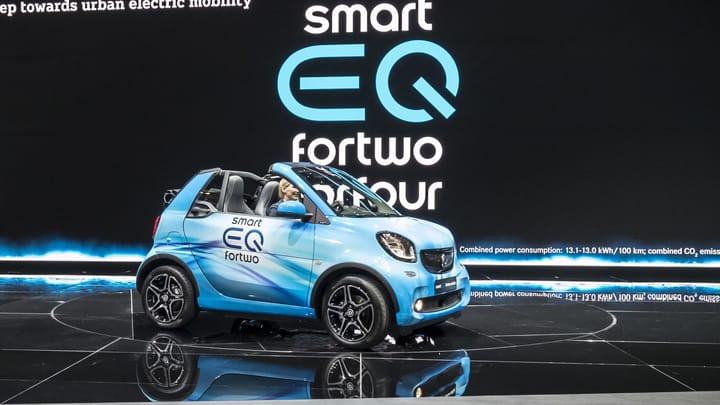Table Of Contents
Understanding SMART Criteria in Lease Management
The Impact of Smart Technology on Leasing
Setting SMART Goals for Lease Renewal or Termination
Trends and Innovations in Smart Leasing
FAQ
In the dynamic world of leasing, the end of a lease term presents both challenges and opportunities. Whether it's a vehicle, property, or equipment lease, understanding how to navigate the lease end efficiently is crucial. This article delves into the application of SMART criteria in lease management, the impact of smart technology on leasing, strategies for lease renewal or termination, and the future trends in smart leasing. By embracing SMART goals and innovative technologies, stakeholders can ensure a smooth transition at lease end, negotiate favorable terms, and adapt to the evolving landscape of lease agreements.
TLDR
- Understanding and applying SMART criteria can significantly improve lease negotiations and closure.
- Smart technology, including IoT and smart contracts, is revolutionizing lease management and monitoring.
- Setting SMART goals is essential for negotiating favorable lease renewal terms or preparing for lease termination.
- Future trends in smart leasing promise further innovations and efficiencies in lease management.
Enhancing Lease Management with Behavioral Economics and ESG Integration
In the intricate dance of lease negotiations and management, the application of behavioral economics principles alongside the integration of Environmental, Social, and Governance (ESG) criteria offers a forward-thinking approach. By understanding the psychological underpinnings of decision-making, stakeholders can craft lease agreements that are not only SMART but also deeply attuned to the human element of negotiations.
Behavioral economics, with its focus on cognitive biases and decision-making processes, provides invaluable insights for enhancing the effectiveness of SMART criteria in lease negotiations. For instance, the principle of loss aversion can be leveraged to frame lease terms in a manner that minimizes perceived losses, fostering more mutually beneficial outcomes. As noted in an article from the American Bar Association, being aware of biases such as anchoring and confirmation bias allows parties to make more rational decisions, leading to agreements that satisfy all involved (source).
Parallelly, the integration of ESG criteria into lease management strategies heralds a new era of sustainable and socially responsible leasing practices. By prioritizing properties that meet high environmental standards, promote social responsibility, and adhere to robust governance practices, companies can align their leasing activities with broader societal values. This not only reduces environmental impact but also enhances relationships with stakeholders and improves long-term property performance. As highlighted by Fire Capital Management, integrating ESG criteria aligns leasing practices with a company's values and mission, mirroring the approach foundations take with their investments (source).
In summary, the fusion of behavioral economics and ESG criteria in lease management strategies offers a comprehensive approach that caters to both the cognitive aspects of decision-making and the growing demand for sustainability and social responsibility. This dual focus not only enhances the negotiation process but also positions companies for success in an increasingly conscientious market.
Understanding SMART Criteria in Lease Management
Overview of SMART Criteria
The SMART criteria, tied to Peter Drucker's Management by Objectives (MBO), offers a neat way to set goals that you can actually hit. It's all about being Specific, Measurable, Assignable, Realistic, and Time-related. This approach makes sure your objectives aren't just pie in the sky but are grounded and doable within a certain period. For the nitty-gritty, hit up the Wikipedia page on SMART criteria.
SMART in Lease Negotiations
Diving into lease negotiations, especially as you're rounding the final corner of your lease, using the SMART criteria can really smooth things out. Let's break it down: Being Specific about what you want, like the buyout price or extending the lease, lays it all out on the table. Making sure these terms are Measurable lets everyone know what's up and whether it's doable. It's key that the goals are Assignable so everyone knows their part. They've gotta be Realistic too—think negotiating a buyout price that makes sense with the car's value. And don't forget Time-related; setting a deadline keeps things moving. This approach doesn't just make the negotiation smoother; it ups the chances of everyone walking away happy.
SMART Goal Setting for Lease End Strategies
Nailing Your Lease Closure with SMART Goals
As your lease is winding down, laying out some SMART goals can make the whole wrap-up a breeze, ensuring you're not left scrambling. Here's the rundown:
-
Specific: Nail down exactly what you've gotta do before the lease is up. Whether it's getting the car inspected, fixing it up, or deciding on the buyout, clarity is your friend.
-
Measurable: Have clear markers for what success looks like, like keeping costs under a certain number or passing the car inspection with flying colors.
-
Achievable: Make sure what you're aiming for makes sense with the lease terms and where you're at financially. Eyeing the buyout? Check it against your budget first.
-
Relevant: Your end-of-lease goals should line up with your bigger picture, whether that's leasing another ride or something else. Do your homework and negotiate terms that fit your game plan.
-
Time-Bound: Set solid deadlines for each step, from decision-making about your next car to getting any repairs done and handing back the keys.
By sticking to the SMART criteria, you're setting yourself up for a smooth and stress-free lease closure. Getting a jump on these goals early means you're not left in a last-minute lurch, saving you both headaches and potentially some cash.
The Impact of Smart Technology on Leasing
Smart Technology Trends in the Leasing Industry
How Smart Contracts and IoT Shake Things Up
The leasing industry is getting a major facelift thanks to two big players: Smart Contracts and the Internet of Things (IoT). These aren't just buzzwords; they're game-changers that are making lease management smoother, more secure, and a heck of a lot smarter.
| Technology | Impact on Lease Management |
|---|---|
| Smart Contracts | They're like autopilot for lease agreements, cutting down on manual work and mistakes. |
| IoT | Keeps an eye on leased assets in real time, making sure everything's up to snuff and maintenance is on point. |
Smart Contracts are a big deal because they automate what used to be a manual, error-prone process. Imagine lease terms coded into a blockchain, making sure everyone sticks to the deal without needing a middleman. This speeds things up and cuts down on arguments.
Then there's IoT, which is like having a 24/7 watchdog for leased assets. It's all about keeping tabs on the condition of what's leased out, ensuring it stays within the agreed-upon limits. This is a win-win, protecting the leasing company's investment and keeping lessees honest.
Put Smart Contracts and IoT together, and you've got a dynamic duo that's pushing lease management into the future. Efficiency, security, compliance—it's all leveling up as these technologies mature and become more common in the industry.
Making Lease Management Smarter with SMART Technologies
Smart Devices: The New Lease Police
Lease management's getting a serious upgrade with SMART technologies. These aren't just gadgets; they're tools that make sure lease agreements are followed to a T. Based on the SMART criteria (Specific, Measurable, Assignable, Realistic, Time-related), these technologies are making everything about lease management more... well, smart.
Smart devices come loaded with sensors and internet smarts to keep an eye on lease agreements in real time. Whether it's checking the condition of a property or making sure usage terms are followed, these devices are on it. They can even send out heads-ups for maintenance or when it's time to talk about renewing the lease. Here's the rundown:
- Specific: They're like hawks, zeroing in on exactly what the lease says.
- Measurable: They deal in hard facts, giving you the lowdown on how the property's being used.
- Assignable: They make it crystal clear who's supposed to do what.
- Realistic: They keep things grounded, sticking to what's actually doable for the leased asset.
- Time-related: They're all about timing, making sure nobody drops the ball on lease deadlines.
By weaving SMART technologies into the fabric of lease management, the whole process becomes more streamlined, transparent, and accountable. It's like having a trusty sidekick that ensures everything's running like a well-oiled machine, making life easier for everyone involved.
Setting SMART Goals for Lease Renewal or Termination
Strategies for Lease Renewal
Negotiating Better Terms with SMART Criteria
When it's time to talk lease renewal, leaning on the SMART criteria can seriously work in your favor to snag terms that better suit you. Here's the breakdown of using SMART to make those negotiations a bit smoother:
-
Specific: Get clear on what you're after. Want your monthly rate to take a dive? More miles on the clock? Or maybe it's about including certain maintenance perks. Pinning down the specifics makes it easier for everyone to get on the same page.
-
Measurable: Put a number on it. If slashing your monthly payment is the goal, don't be shy about naming your price. It keeps things transparent and lets you know if you're hitting the mark.
-
Assignable: Who's on deck for what? If there's stuff that needs doing, like upkeep or check-ups, make sure it's spelled out who's handling it.
-
Realistic: Keep your head in the game. Shooting for the stars with a super low payment might not fly if it's way off from what's going around. A quick look at current deals can give you a reality check on what's doable.
-
Time-bound: Put a clock on it. Agreeing on when the new terms kick in and setting deadlines for any must-dos keeps everyone in line and moving forward.
Rolling with the SMART approach not only sets you up for a win by clarifying and aiming for realistic outcomes but also keeps the negotiation vibe professional and on track.
Prepping for Lease Termination
Smooth Moves with SMART Goals
As the curtain falls on your lease, having SMART goals can make the exit as graceful as possible. Here's how to apply SMART to bow out without a hitch:
-
Specific: Nail down your to-dos. This means booking that final inspection, sorting any repairs, and making sure your payment history is spotless.
-
Measurable: Define what "success" looks like. Aiming to hand back the vehicle in tip-top shape as per your lease terms can save you from last-minute charges.
-
Achievable: Be real with what you can pull off. If there's fixing up to do, don't leave it to the eleventh hour.
-
Relevant: Keep your eye on the prize. Focus on actions that'll ease your lease-end process, like dodging extra fees and ticking off all the lease requirements.
-
Time-Bound: Set your deadlines. Wrapping up repairs a month out, for instance, leaves wiggle room for any surprises.
Sticking to these SMART goals can help you steer clear of common lease-end pitfalls, ensuring you transition smoothly to whatever's next, be it a shiny new lease or another adventure.
Trends and Innovations in Smart Leasing
Future of Smart Leasing
Innovations Shaping the Future of Lease Agreements
Lease agreements are getting a major facelift with the help of tech and some pretty smart thinking. Gone are the days of drowning in paperwork and dealing with guesswork in lease assessments. Now, we're talking digital contracts and AI that does the heavy lifting, making things a whole lot smoother for everyone involved.
And it's not just about making things easier. People are now looking for leases that do good for the planet, like driving an electric vehicle or working in a building that's got its green badge of honor. Plus, life's unpredictable, right? So, having the option to tweak your lease terms when things change is a big win.
Let's break it down with a quick side-by-side:
| Feature | Traditional Leasing | Smart Leasing Innovations |
|---|---|---|
| Contract Management | All about that paper | Digital and automatic |
| Lease Assessment | Cross your fingers it's right | AI's got your back |
| Sustainability | Not really on the radar | Think EVs and green buildings |
| Flexibility | Take it or leave it | Your lease, your rules |
These upgrades are making leasing not just more user-friendly but also a better fit for how we want to live our lives today—valuing both convenience and our planet.
Smart Leasing Case Studies
Real-World Examples of SMART Goals in Lease Management
Setting SMART goals isn't just business jargon; it's a game-changer for managing leases. It's all about being clear on what you want to achieve and how you're gonna get there. Here's how it plays out in the real world:
- Specific: Imagine a company that wants to cut down on lease costs. They aim for a 10% drop in the next year. That's a goal you can see and measure.
- Measurable: They keep an eye on the prize by checking the numbers each month. If things aren't adding up, they pivot.
- Assignable: Everyone's got their part to play, from the finance buffs to the legal eagles.
- Realistic: They're not shooting for the stars. A 10% cut? Totally doable with their creds and connections.
- Time-related: They've got a year to make it happen. Tick tock.
By sticking to the SMART playbook, companies can make sure they're not just throwing darts in the dark. It's about having a plan that's clear, doable, and on a deadline. And hey, for a deeper dive into SMART goals, hit up the Wikipedia page on SMART criteria.
FAQ
What are the SMART criteria?
The SMART criteria stand for Specific, Measurable, Assignable, Realistic, and Time-related. This framework is designed to help set clear, attainable goals within a specific timeframe, ensuring that objectives are not just ambitious but also achievable and relevant.
How can SMART criteria be applied to lease negotiations?
In lease negotiations, applying the SMART criteria involves being specific about terms such as buyout prices or lease extensions, ensuring these terms are measurable and clear, assigning responsibilities clearly, setting realistic goals that reflect the asset's value, and adhering to a time-bound schedule to keep the process moving efficiently.
What role do Smart Contracts and IoT play in lease management?
Smart Contracts automate lease agreements, reducing manual errors and ensuring compliance with terms through blockchain technology. The Internet of Things (IoT) monitors leased assets in real-time, ensuring they are maintained properly and used within agreed parameters, enhancing efficiency and security in lease management.
How can SMART technologies improve lease management?
SMART technologies, equipped with sensors and internet capabilities, ensure lease agreements are closely monitored and adhered to. They provide specific, measurable, assignable, realistic, and time-related data on the use and condition of leased assets, making lease management more streamlined and transparent.
What strategies can be used for lease renewal using the SMART criteria?
For lease renewal, using the SMART criteria involves being clear about desired changes (specific), quantifying those changes (measurable), clarifying responsibilities (assignable), setting achievable goals (realistic), and establishing a timeline for negotiations and implementation (time-bound).
How can SMART goals facilitate a smooth lease termination process?
Applying SMART goals to lease termination involves specifying necessary actions (like inspections and repairs), setting measurable standards for the condition of the asset, ensuring tasks are achievable within the lease terms and personal capabilities, focusing on relevant actions that facilitate the process, and adhering to a strict timeline to avoid last-minute issues.
What innovations are shaping the future of lease agreements?
The future of lease agreements is being shaped by digital and automatic contract management, AI-assisted lease assessments, a focus on sustainability (like electric vehicles and green buildings), and increased flexibility in lease terms to accommodate life's unpredictability.
Can you provide a real-world example of SMART goals in lease management?
A company aiming to reduce lease costs by 10% within a year is a real-world example of applying SMART goals. This involves setting a specific and measurable target, assigning tasks to relevant team members, ensuring the goal is realistic with the company's resources, and setting a time-bound plan to achieve the reduction.
Why is it important to set SMART goals for lease management?
Setting SMART goals for lease management is crucial because it ensures that objectives are clear, achievable, and relevant. This structured approach prevents miscommunication, enhances efficiency, and increases the likelihood of meeting or exceeding the set goals within the desired timeframe.
How do SMART technologies contribute to sustainability in leasing?
SMART technologies contribute to sustainability in leasing by enabling more efficient use of resources, monitoring and ensuring compliance with environmental standards, and facilitating the leasing of green assets like electric vehicles and eco-friendly buildings. This aligns lease management practices with broader environmental goals and consumer preferences for sustainable options.



